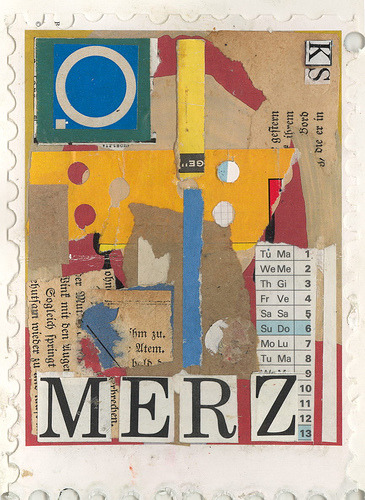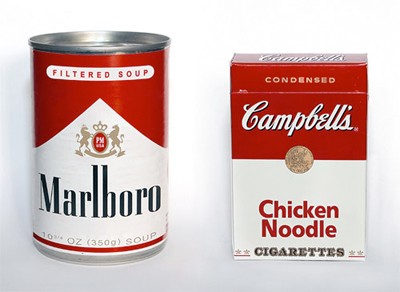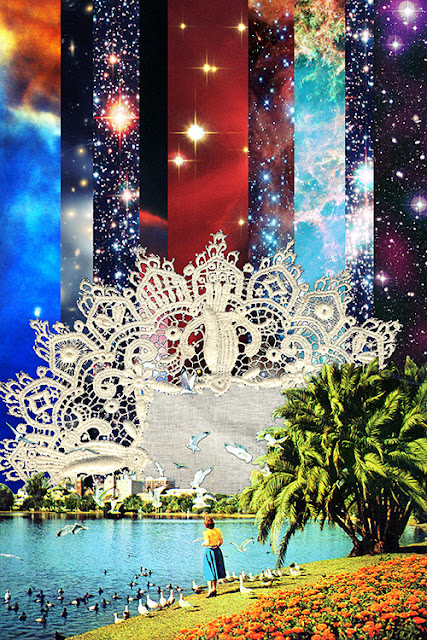
Kurt Schwitters: the pop art pioneer who brought order to chaos
In
October 1945 the German artist Kurt Schwitters, who had been living in Britain
since 1940, wrote a fairytale about a man with a glass nose. At first the man's
nose is covered with skin and looks much like a normal nose, but the skin
gradually becomes thinner and eventually vanishes completely. What it reveals
is quite the work of art: the nose "could reflect the most improbable
lights and colours and allowed objects to shine through in fragments".
Soon, everyone wants to have a glass nose. Unfortunately, such noses also have
a downside: they allow you to smell people's true thoughts, and those who
compliment him most smell the worst. Don't listen to people, seems to be the
moral of the story. Or in the words of Schwitters's anti-Pinocchio to his
flatterers: "You smell of cheese!"


A typical Schwitters collage can look like the result of an explosion in a printer's workshop: there are playing cards, sweet wrappers, torn bus tickets, magazine cuttings and rusty nails. The Skittle Picture from 1921 looks like someone has thrown a bowling ball through a toy shop window and glued the result on a canvas: a mess – at first sight. If you look more closely, you realise how carefully assembled the collage is, and how removing just the tiniest snippet would upset a delicate balance. Counterfeits of Schwitters collages have been sold at London fleamarkets since the 1950s (art historians have identified up to 700, and some of them are archived in the British Museum), but it's surprising how easy it is to tell the fakes from the real thing. With Schwitters, chaos had a method.

He
worked in collage and paint, sculpture and performance, poetry and fairytales,
and so identifying him with a single "school" of art is notoriously
difficult. Schwitters is most commonly associated with Dada, though many
Dadaists thought he was an oddball and a romantic ("the Caspar David
Friedrich of the Dadaist revolution", the poet Richard Huelsenbeck said
waspishly), but he was far too ironic to be a romantic, too abstract to be a
surrealist and too anarchic to be a constructivist. Schwitters called his own
art "Merz", which in itself is a random cut-off from the word
"Kommerz". The apotheosis of Merz was a giant walk-in collage in his
parents' home, filled with broken toys, glass bottles and pictures, which he
called the Merzbau (the Merzbuild). If Schwitters was about anything, Merz
summed it up: art that was not just about the proper, the polished and
beautiful, but about offcuts, shards, broken bits, rubbish, the common detritus
of life.

In
Germany, this strategy had been a success. Not in the sense that Schwitters's
art had made him a fortune, but in that he'd been able to earn a living as an
artist. Though he steered clear of the avant-garde salons of Berlin, he kept in
touch with Dutch, French, Russian and American artists by post. And in his provincial
hometown of Hanover, there was a network of modern-minded collectors and
gallerists who kept him busy with commissions. In the summer of 1920 a nonsense
poem called "Anna Blume" ("Anne Blossoms") turned
Schwitters into a local celebrity after his publisher pasted a poster with it
all over town. And in Germany, Merz lives on: as recently as 1997 the German
band Freundeskreis had a top-10 hit with a hip-hop track using "Anna
Blume" as lyrics; and in Hanover, there is now a museum largely dedicated
to his work, located on Kurt Schwitters Square.

The Merz Barn in Cumbria. None of the artworks
inside the barn are original – they are other artists' interpretations of how
they thought it might have developed had Schwitters lived longer. Photograph:
Mark Pinder

In
Britain, though, things didn't go so well. Schwitters had left Germany for
Norway in 1937, after the Nazis had featured "Anna Blume" and two of
his collages in their Degenerate Art exhibition. When Germany invaded Norway in
April 1940, he moved on to Britain, but he was hardly welcomed with open arms:
for the first four months, he was interned in Edinburgh, York and on the Isle
of Man as an enemy alien.

After
his release, Schwitters settled in Barnes, west London, but life remained hard.
The London art establishment was not so much uninterested in modern German art
as actively opposed to it. Raymond Unwin, the prominent architect, declared
around this time that Germans "take up a theory readily, and follow it
devotedly, so that at first glance they might be blind to limitations which we
are quicker to catch a glimpse of". Where bad politics had sprouted, no
good art could grow. Kenneth Clark, the then director of the National Gallery,
had declared Germany "very much not my spiritual home" and condemned
the influence of abstract art on British artists. He was too polite to say this
to the artist's face, of course. "Why did the director of the National
Gallery not even want to see me?", Schwitters scribbled in his notebook.
"He does not know that I belong to the avant-garde in art. That is my
tragedy."

Ineligible
for public funding through the War Artists Scheme, Schwitters earned a living
by taking on portrait commissions. When he did get the odd collage into an
exhibition, it was ridiculed. A Daily Sketch report on a show at the Modern Art
Gallery in 1944 has a man pulling a puzzled face next to a Schwitters
sculpture: "Oo! Oo! The Oodle: An Adventure in 'Art'", the headline
reads. When he organised a performance of his Ursonate poems ("Fümms bö wö
tää zää Uu, / pögiff / kwii Ee") in 1944, two BBC representatives attended
but left halfway through.


In
the autumn when Schwitters bundled all his frustration with the English way of
life into "The Man with the Glass Nose", he had just managed to
escape London, and he and his new English girlfriend Edith Thomas had settled
in the picturesque town of Ambleside in the Lake District. Strangely, it is at
this point that Schwitters's life took a fairytale turn. Impoverished and
recovering from a stroke, he befriended the retired landscape gardener Harry
Pierce, who loaned him a dilapidated shed on his idyllic plot of land nestled
on the Langdale hillside. In the final months of his life, Schwitters worked
happily on a new version of the Merzbau, the Merzbarn. On 8 January 1948, a day
after learning he had been granted British citizenship, he died of acute
pulmonary oedema.
"Thanks
to England, we live in an idyll," he had written to a friend not long
before, "and that suits me just fine. England in particular is idyllic,
romantic, more so than any other country." The Dada rebel who had found
London too quiet somehow found a new spiritual home in the land of Peter Rabbit
and Mrs Tiggywinkle.
There's
also something neat about Schwitters's homecoming. To understand why, you need
to visit the Merzbarn in Elterwater, then hike up and down the next set of
hills. In under 45 minutes, you end up at Dove Cottage, the former home of
William Wordsworth. Wordsworth and Coleridge, it is worth remembering, became
towering figures of English Romanticism only after a trip to Germany in 1789.
Wordsworth didn't compose The Prelude in the Lakes – he had to travel all the
way to the cold clammy Harz mountains to do so. And Goslar, the "old
decaying city" in which Wordsworth wrote its first verses is only a short
train journey from Schwitters's hometown of Hanover.
It's
tempting to call this a closing circle, but perhaps a more appropriate image is
that of a spiral of influences: a perfect metaphor for the constructive
relationship between two countries that in spite of their similarities have
always found it difficult to progress in sync. Schwitters and Wordsworth had to
go abroad and be homesick in order to find out who they really were.
The
original Merzbarn isn't part of the upcoming major retrospective at Tate
Britain: the wall that he finished was discovered by Richard Hamilton in the
1960s and moved to the Hatton Gallery in Newcastle upon Tyne, where it remains.
It was in any case unfinished and is rather underwhelming.
From Ice Age beasts to Pop Art blondes
The new year’s most enticing exhibitions span millennia of artistic achievement, says Richard Dorment.
Nobody uses the word “unmissable” in real life. When it’s used by critics it usually means “good”. But every so often no other word will do for calling attention to exhibitions that will only be around for a few months and may never happen again. This year, a few exhibitions that fall into that rare category are coming to London.
The Royal Academy’s Manet: Portraying Life is the first show to look at Edouard Manet’s portraits as distinct from his scenes of modern life. Manet is the perfect artist to usher in the new year, a blast of fresh air who clears away the cobwebs and makes you sit up and pay attention (Jan 26 - Apr 14) .
And in the early spring the National Gallery stages one of those shows you’d think could not be done: a display of 16 major altarpieces by one of the most lovable masters of the Italian Renaissance, Federico Barocci. The scale and importance of loans that will be coming from the Marche region of Italy is so staggering that for a moment I wondered whether there hadn’t been some natural disaster that necessitated removal to London of pictures like his sublime The Last Supper from the cathedral at Urbino. (February 27 - May 19).
Then there is the mad and inspired project to temporarily repatriate the series of Old Master paintings sold from the collection of Robert Walpole, Britain’s first prime minister, to Catherine the Great in 1779. Now among the glories of the Hermitage, they will hang for the summer in their original setting – that most beautiful of all Palladian houses, Houghton Hall in Norfolk. (May - September).
More important than any temporary exhibition in 2013 are the opening of new or renovated exhibition spaces. After the scandal of its 10-year closure, on April 13 the Rijksmuseum in Amsterdam will once again open its doors to the public. Here in London the elegant former munitions store that’s being renovated by Zaha Hadid in Kensington Gardens will open this summer as the Serpentine-Sackler Gallery.
Peter Blake: Pop-art ‘godfather’ still an outsider
LONDON — Pop music loves him. The art establishment shuns him.
At the age of 80, British artist Peter Blake is revered for his celebrated Sgt. Pepper Beatles album cover yet at the same time dismissed as too “cheerful” to be one of the greats.
Stroking his wispy silver beard repeatedly and using a cane to walk around a central London gallery, the man dubbed the “godfather of pop art” still struggles to come to terms with his place in the world of contemporary culture.
“It’s a cross I bear,” he said of the fact that his art is not taken as seriously as that of some contemporaries.
“Perhaps it’s surprising that at my kind of age and with my infirmities I’m still cheerful,” he said at the Waddington Custot Galleries, where his latest show, “Rock, Paper, Scissors,” is on view.
Surrounding him are works ranging from some of his earliest watercolors, executed in 1948 when he was 16, to The Family, a sculpture he completed just a few days ago.
What is striking is how lively they are — plastic figures of Snow White and 30 dwarfs crowd outside a model of a Swiss chalet in one humorous work, and the 6-foot-long A Parade for Saul Steinberg is a model bursting with color and references to popular culture.
Blake concedes that he is often left having to defend his work in a world in which “serious” art is cherished above all.
“Painters all have a different reason to paint. It could be politics; it could be angst; it could be anger. My reason to paint is to make magic and to make cheerful things.”
The art market clearly ranks his peers above Blake, including David Hockney, whose Beverly Hills Housewife fetched $7.9 million at auction in 2009.
But more of a bugbear is being overlooked by Tate Modern, the most important British gallery for modern and contemporary art — which, ironically, gave a major retrospective this year to a much younger artist whom Blake helped nurture, Damien Hirst.
After uttering a few choice words in what he himself called a “rant” to a newspaper against influential Tate director Nicholas Serota, he sought to strike a more conciliatory tone.
“Oddly enough, Serota came in earlier to see the show,” Blake recalled.
What Serota saw was an artist still bursting with ideas in a phase of life Blake describes as an“encore” to the main acts of his career.
Blake named the show after the children’s game rock-paper- scissors, and childlike touches surface throughout.
Blake was producing art by 1945, at age 13, and in the 1950s and “swinging ’60s” emerged as one of the front-runners of pop art, which drew on popular culture and advertising to subvert the traditions of mainstream art.
He is best-known for designing the album sleeve for the 1967 Beatles album Sgt. Pepper’s Lonely Hearts Club Band, featuring a collage of famous figures behind the band members dressed in bright military-style regalia.
That album has led to a lifelong association with British pop music, including designing sleeves for the charity single Do They Know It’s Christmas? in 1984, the latest album by Madness and the Brit Awards statuettes last year.
Subscribe to:
Posts (Atom)











.jpeg)

.jpg)

.jpeg)


.jpg)

.jpeg)







